Why are coronavirus tests so difficult to produce?

By Sheldon Campbell and Randi Hutter Epstein22nd April 2020
Testing for a new disease will always have teething problems. But when a global pandemic means more tests need to be done faster than ever, how do you keep up with the virus?
W
When it comes to halting the Covid-19 crisis, virus testing is key for diagnosing and for tracking the epidemic. It’s the only way to uncover just how many people have been infected, or could infect others.
Despite how crucial testing is, some countries have far more tests than others – and that testing isn’t available to everyone. The reason comes down to several factors, including timing, logistics, and the complexity of collecting samples, obtaining the raw materials and equipment for testing, and having the expertise to do the tests accurately.
The countries that acted swiftest in terms of testing have also been among the largest successes of the virus’s containment. Take South Korea, which began testing early in clinics, hospitals and drive-through centers. Its first confirmed case was on 20 January 2020. Six weeks later, on 16 March, South Korea was testing 2.13 people per 1,000. Italy, on the other hand, which had its first confirmed case on 31 January, was testing 1.65 people per 1,000 six weeks on. Even while Italy ramped up its numbers significantly – it is now testing a far higher percentage of its population than South Korea, at 24.5 people per 1,000 compared to South Korea’s 11 – the slower start was one factor that made it harder to contain infections overall. (Figures range elsewhere: Spain is currently testing 20 people per 1,000, Australia 17, Canada 15, the US 12 and the UK six.)
You might also like:
- Can you catch Covid-19 twice?
- The race to build coronavirus ventilators
- What is Covid-19’s real death rate?
Starting testing later often meant the virus had chance to spread through whole communities by the time testing was implemented. Then came simple economics: as demand spiked, supplies were drained. The countries that reacted slowly required more tests to identify many more infections as a result.

A medical professional administers a Covid-19 test in Bolinas, California on 20 April 2020; the town is attempting to test each of its 1,600 residents (Credit: Getty Images)
Testing alone does not cause declines in disease. There are still questions about how reliable test results are for people who are asymptomatic, for example. And the biggest strides have been seen in countries that combined testing with contact tracing and containment measures. Even so, testing allows public health authorities to gather data to make appropriate policy decisions – including about whether more selective or stricter social distancing policies are necessary.
Why ramping up testing is so difficult
Lagging countries are still trying to increase testing capacity. In early April 2020, for example, the UK Health Secretary announced an initiative to scale up to 100,000 tests a day by the end of April, a ten-fold leap from 10,000 a day at the end of March.
But when it comes to Covid-19 tests, scaling up by factors of 10 or 100 is not as simple as stocking up when emergency hits.
That’s because the process of accurate Covid-19 testing requires coordination of a number of processes. First, you must acquire the test kits – the long nasal swabs and chemicals required to process them. These are then sent to expertly-trained laboratory technicians who analyse the samples using a PCR machine, which can be laborious. And finally, there needs to be a system to accept samples and report results to the right people.
Laboratories that were previously doing research only (as opposed to testing for patient care) not only have to run tests accurately – they also have to implement new computer and administrative systems to collect patient information and then to distribute the results back to the health care providers.
Making matters more complicated, many countries, including the UK and the US, have had problems getting enough supplies for testing. It’s not so much a matter of lacking the raw materials but making sure they are pure and mixed in the right amounts. Each brand of test has their own unique blend of about 20 chemicals. Each set requires its own unique packaging. Roche reagents don’t fit a Cepheid any better than a Chevy truck part fits a Prius. Making test kits is as burdensome as drug-making.

Workers prepare components for testing kits in South Korea in March 2020; getting enough supplies for testing has been a challenge for many countries (Credit: Getty Images)
In addition to chemicals, many laboratories lack the government-approved machines. In the US and South Korea, laboratories were allowed to file a so-called Emergency Use Authorisation application. This lets labs develop their own tests based on government protocols, but tweak them according to equipment.
As a general rule, the easier a test is to perform, the harder it is to manufacture. The first Covid-19 tests were simple to make but required specialised expertise. Many early tests take about four hours – two hours of hands-on work, two hours in the machines. Roche and Abbot instruments, available in some academic laboratories, can run 80 to 100 samples at a time. They’re partially automated but still require skilled technicians. Simpler tests that smaller hospital labs can run are hitting the market, but availability is sparse.
Once a laboratory is set up and tests procured, the process can begin – starting with the pre-test.
Pre-test procedure
The pre-test begins with a nasal swab. This is not an ordinary cotton ear-bud but a long, skinny stick that is flexible enough to extend to the ear. The swab is nylon or foam, not cotton, which inhibits the test.

The nasal swab is a long, skinny stick that extends to the ear (Credit: Getty Images)
Even procuring those swabs has been difficult thanks to the crisis. Copan Diagnostics Inc, based in northern Italy, had to receive special government permission to continue production despite the Covid-19 lockdown. Puritan Medical Products, based in Maine, suffered labour shortages.
As a result, nasal swabs are now precious. A few entrepreneurs are trying to make more with 3D printing, but there have been teething problems, as with any brand new technology. And the vendors are charging 10 times or more what swabs used to cost.
Once the swab gets to the laboratory, a highly-skilled laboratory technician, wearing the same protective clothing as nurses and doctors, places it into a biosafety hazard box – a glass box with controlled air flow to prevent the virus from escaping.
The process is dangerous. Laboratory work generates droplets. Just one droplet may contain a million or so viruses that can contaminate the laboratory worker or the laboratory. It can also land in another sample. If that happened, a patient who didn’t have Covid-19 would be told they did.
Laboratory directors love the cooking metaphor. Running a lab test, they say, requires a chef’s attention to detail, measuring precisely each ingredient at the right time, in the right order and at the right temperature. But unlike cooking – where a little bit of extra spice here or there may enhance the final product, or at worst case ruin the flavour – a faulty lab test can produce deadly results.
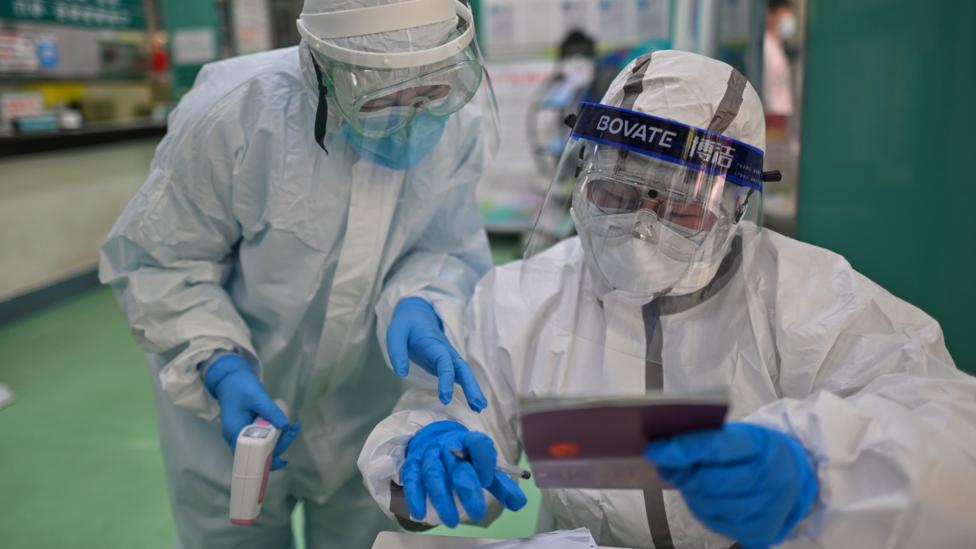
A single droplet being tested can contain a million viruses, making it crucial that medical professionals wear full protective gear (Credit: Getty Images)
“One hiccup throws everything off,” said Dr. Kimberle Chapin, professor of pathology, laboratory medicine, and medicine, at the Warren Alpert School of Medicine at Brown University and director of microbiology for the Lifespan Academic Medical Center, Rhode Island.
Expert technicians with the meticulous skill to run the test are a scarce commodity in many countries.
The testing phase
The testing phase requires two crucial steps. First, extraction – retrieving the potential virus from the muck of the mucus on the swab, and second, detection.
With garbed arms, technologists manipulate samples into tubes to be loaded onto an instrument where chemicals break open the viral coat (the “crown” of the coronavirus), and isolate the pure RNA, a single strand of genetic material.
Next, they pipette the RNA into a disc with tiny wells. Each has the reagent that hunts for particular pieces of the Covid-19 viral genome.
The discs are taken to a machine where chemicals multiply short pieces of the viral genome about a billion times. These short pieces are then detected by a fluorescent probe that glows if Covid-19 is there.

An employee holds up a Covid-19 testing kit in Chuncheon, South Korea (Credit: Getty Images)
If the patient’s sample did not have the virus, then nothing happens. No multiplication. No glow.
The technologist then checks the controls (the known positive and negative samples that prove the run worked), enters the results into the computer, and calls in the results.
Ensuring accuracy
The only thing worse than no test is a test that’s wrong. Laboratories can only start testing patients after they have done sufficient studies to ensure reliability. These tests usually take upwards of six weeks, but technicians have been working double shifts to speed the process.
To make matters more complicated, sometimes a patient can test negative even when they’re sick. They may have the virus in their lungs, but no longer release it near the nose where it would stick to the swab. Or, the sample was not obtained correctly.
Of course, this all describes swabbing as a means of searching for a live virus in the patient.
But the latest buzz in testing is the blood test: the antibody or serology test, which could be used to establish if someone had the disease in the past and developed immune cells to recover from it. It detects one specific part of a patient’s immune response to the disease – the presence of antibodies. It is hoped these proteins might protect patients from reinfection, although any protection remains to be seen.
Devising an accurate antibody test ushers in a whole new set of challenges. It must ensure that it’s spotting the precise immune cells that fought this particular germ, and not some run-of-the-mill coronavirus, like the common cold. And some people might recover from the disease without ever developing antibodies.

A medical specialist tests blood samples for Covid-19 in Hanoi, Vietnam (Credit: Getty Images)
Even then, we do not know enough about Covid-19 yet to know if infected patients are no longer susceptible. (Read more about whether you can get Covid-19 twice). Nor are there any proven, reliable antibody tests. The UK bought millions of antibody tests that didn’t work.
If we have learned anything so far, it’s this: we can no longer ignore the warnings of infectious disease experts who, for decades, have been calling for global preparedness for the inevitable new, dangerous viruses. One part of this preparation includes a worldwide system to rapidly develop, prove, and distribute tests for a new virus as soon as possible after it strikes.
Now more than ever, we rely on the dedicated laboratory workers most of us will never see and yet are crucial members of the first-responder teams.
Sheldon Campbell, MD, PhD is a professor of laboratory medicine at Yale and associate chief for the clinical laboratories for the VA Connecticut Healthcare System. Randi Hutter Epstein, MD is the writer in residence of Yale School of Medicine and author of Aroused: The History of Hormones and How They Control Just About Everything.
--
As an award-winning science site, BBC Future is committed to bringing you evidence-based analysis and myth-busting stories around the new coronavirus. You can read more of our Covid-19 coverage here.
If you liked this story, sign up for the weekly bbc.com features newsletter, called “The Essential List”. A handpicked selection of stories from BBC Future, Culture, Worklife, and Travel, delivered to your inbox every Friday.
The heart-wrenching choice of who lives and dies
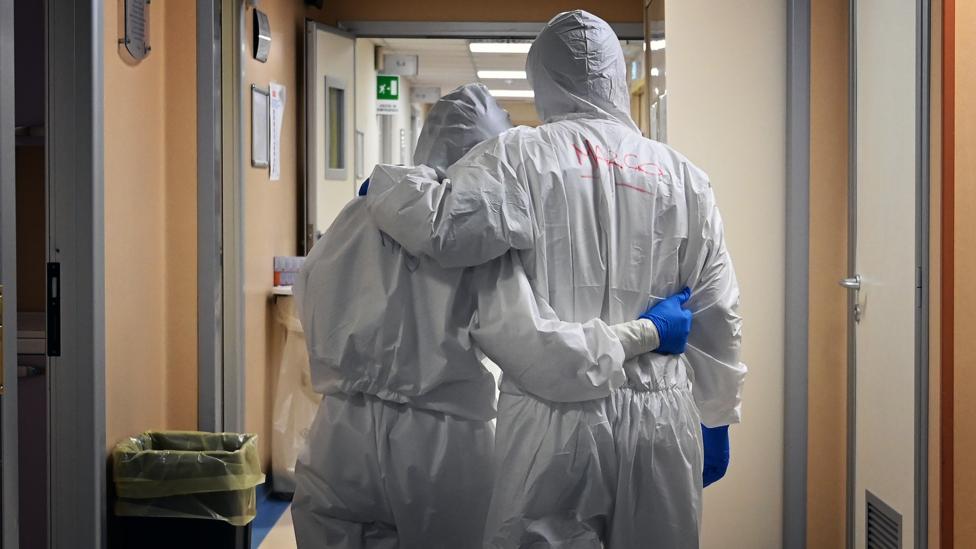
By Abigail Beall28th April 2020
Shortages of equipment, beds and staff means doctors have a dreadful decision to make in the midst of the current pandemic.
T
There is something strangely quiet about the wards of coronavirus patients in Lodi, Italy. Even though the hospital corridors bustle with medical staff, the patients make little noise, says Stefano Di Bartolomeo. For a doctor experienced in working in conflict situations, this pandemic has felt unusual.
“Everybody has their own little bag with personal belongings on the ground or hanging from their trolleys,” says Di Bartolomeo, an anaesthetist working at a hospital in Lodi. Nobody is allowed visits from their family members, so their phones are the only line of communication. Many patients, although critically ill, do not feel they are that bad, and some don’t even notice trouble breathing.
Perhaps most unusually of all, even though many require a bed in intensive care, they won’t all get put into one. When a bed in intensive care does become free, the doctors must decide which patient it will be given to.
You might also like:
• How do you beat a global outbreak
• Can you catch Covid-19 twice?
• Why some racial groups are more vulnerable to Covid-19
• Can you catch Covid-19 twice?
• Why some racial groups are more vulnerable to Covid-19
Di Bartolomeo, who has a background in tropical medicine and epidemiology, began at the Lodi hospital in mid-March. It was a shock: cases there had already reached 1,100 by 13 March. “The hospital has been coping with the situation, but at the same time [it’s] completely overwhelmed,” he says.
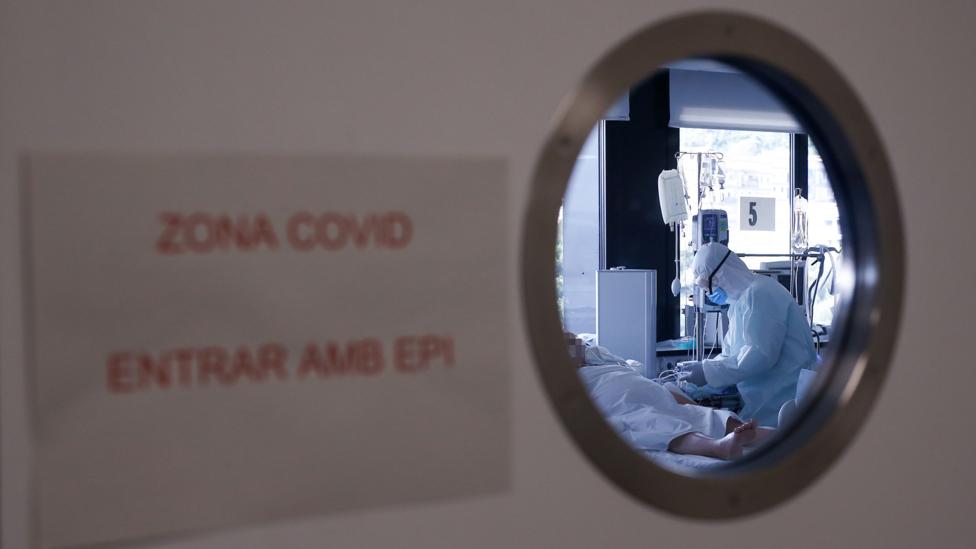
Much of the equipment needed to treat Covid-19 patients is in limited supply, forcing doctors to decide who gets it (Credit: Getty Images)
Di Bartolomeo is currently working on a ward where patients are given non-invasive ventilation while they wait for a bed to become available in intensive care, where they can be intubated with a tube placed into their airways through their mouth. But not all patients are put through to his ward. “Some patients, because they are too old or too sick, they are just put on oxygen,” Di Bartolomeo says. “They are not candidates for other forms of more invasive support like CPAP (continuous positive airway pressure) or non-invasive ventilation.”
Difficult decisions
As the number of people who have tested positive for coronavirus around the world exceeds three million this week, the virus is stretching health services to breaking point. As of 28 April, more than 212,000 people have been confirmed to have died with the virus. In hospitals across many of the 210 countries to have been hit by the pandemic, beds are filling up with Covid-19 patients.
In some cases, important resources like ventilators, protective equipment and even medical staff are becoming scarce. Doctors are being forced to make a choice of who to prioritise caring for.
But how can anyone put more value on one life over another – never mind someone who has sworn to “do no harm”?
Medical groups have tried, although their resulting guidelines – and the logic behind them – have come under strong criticism.
How can anyone put more value on one life over another – never mind someone who has sworn to “do no harm”?
On 23 March 2020, a group of doctors and academics from around the world published a set of ethical guidelines in the New England Journal of Medicine (NEJM), outlining how to ration resources during the Covid-19 pandemic. Among the recommendations made by the paper’s authors is that at times like this, the usual approach of treating people on a “first-come, first-served” basis should not apply. It also urges prioritising severely ill patients who are younger and who have fewer existing health conditions.
This echoes guidelines given to Italian doctors, which say they may need to prioritise those who will have the greatest chance of successful treatment. Published on 6 March 2020, the Italian guidelines compared the circumstances doctors and nurses are working under to “catastrophe medicine” and stated that it “may be necessary” to place an age limit on those being admitted to intensive care.
“The top consideration is maximising benefits in terms of the number of lives saved and the number of life years saved,” says Ezekiel Emanuel, chair of the Department of Medical Ethics and Health Policy at the University of Pennsylvania and co-author of the paper.

For some health care workers, the emotional turmoil of the pandemic could have lasting effects (Credit: Getty Images)
The argument is that younger, healthier people have a much greater chance of survival, and also a greater life expectancy. Diverting scant resources to these people delivers benefits to the largest number of people, is how the theory goes.
But even for those who accept that logic, it isn’t watertight: the implication, for example, is that both a young person and an old person each on ventilators have the same mortality risk when left unaided, and that a young person taken off a ventilator wouldn’t be more likely to survive than the older person.
The NEJM paper also urges giving groups of people who provide the most value in fighting the pandemic – such as frontline healthcare workers and others who keep key infrastructure going – priority access to medical equipment and treatment on the basis that their jobs require significant training and so they are difficult to replace.
“Because maximizing benefits is paramount in a pandemic, we believe that removing a patient from a ventilator or an ICU bed to provide it to others in need is also justifiable and that patients should be made aware of this possibility at admission,” the researchers write.
Ethical issues
These sorts of decisions are only ever likely to be necessary when hospitals and health care systems are under the most extreme pressure, when cases are at their highest and resources stretched to breaking point.
But de-prioritising vulnerable parts of the population – those who are older or who have pre-existing health conditions – obviously raises serious ethical questions.
That’s all the more true because these populations may be even more vulnerable not only to dying from Covid-19, but from getting infected to begin with. People whose health conditions mean that they require the support of others to eat, dress and bathe, for example, are less able to socially distance.
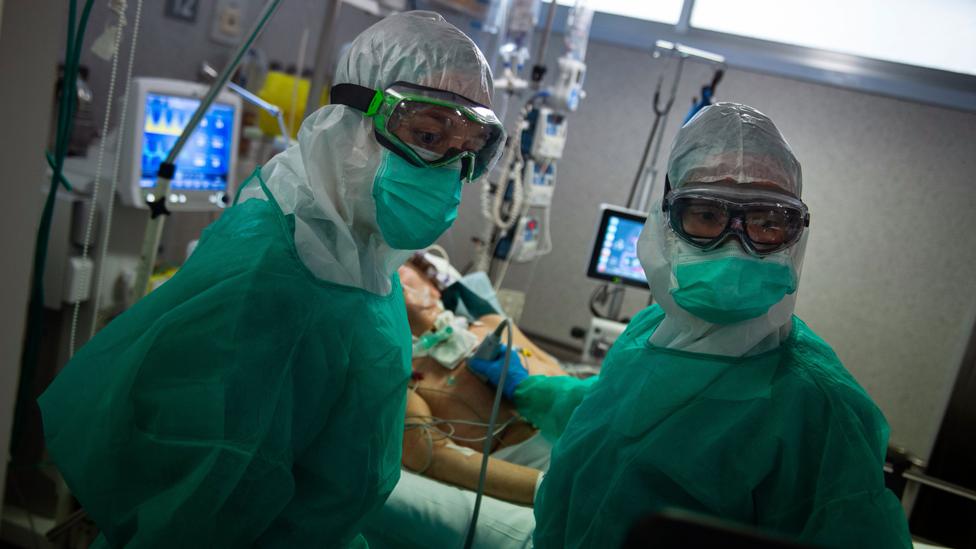
The protective equipment that medical staff have to wear can make the whole experience more frightening for Covid-19 patients (Credit: Getty Images)
Meanwhile, the disease has spread quickly around the world through hundreds of nursing and care homes – with devastating results. In England and Wales, a third of all coronavirus deaths have been in care homes, with 2,000 deaths in a single week, for example. Similarly disproportionate numbers have been seen across Europe and in the US, where one-quarter of Covid-19 deaths have been in nursing homes.
Many organisations that support older people are concerned.
"For many years we have known that chronological age is a very poor proxy for an individual’s health status and resilience – something we all see among the older people in our lives," say the heads of a number of British age-related charities including Age UK in a joint statement. "The fact that someone is in need of care and support, in a care home or their own home, should not be used as a proxy for their health status, nor blanket policies applied – for example, over whether they should be admitted to hospital."
An open letter to the British Medical Association, co-signed by that charity Disability Rights UK, also raised concerns that the rights of disabled people are not being upheld.
“Our individual chance of benefiting from treatment should we have Covid-19 must not be influenced by how our lives are valued by society,” the letter says. In response, NHS England insisted that it was seeking to “fully protect the rights of people with disabilities” throughout the course of the pandemic.
Disability groups in the US have also warned against the “deadly form of discrimination” facing people with disabilities during the pandemic
But many of the countries hit hardest by the coronavirus have found themselves having to ask their doctors to make difficult choices about who to prioritise. And those choices are not always based on clear-cut evidence.
In the US, for example, some states already had guidelines in place to address potential ventilator shortages prior to the pandemic. A report in the New York Times examined the publicly available guidelines, from Alabama, Arizona, Kansas, Louisiana, Maryland, Michigan, New York, Pennsylvania, Tennessee, Utah and Washington State, to see how they varied in their definition of who to prioritise for treatment.
In some instances, documents showed that patients with neurological impairments, dementia or Aids might be excluded from receiving ventilator support in some states. Alabama’s plan wrote that those with “severe mental retardation, advanced dementia or severe traumatic brain injury may be poor candidates for ventilator support”, yet went on in the next sentence to add that “the average life expectancy of persons with mental retardation now spans to the seventh decade and persons with significant neurological impairments can enjoy productive happy lives.” The decade-old Alabama plan has since been replaced with another set of guidelines following a challenge lodged by US disability rights groups. The new guidelines, however, do not tackle how physicians should prioritise ventilator triage at all.
Disability groups in the US have also warned against the “deadly form of discrimination” facing people with disabilities during the pandemic. "Every life is valuable," says Neil Romano, chairman of the National Council on Disability. "In this unprecedented crisis, it is crucial that each state respond to COVID-19, not only by supporting its medical professionals' abilities to treat, but by committing to protect the civil rights of its residents with disabilities."

In many countries, medical staff are being publicly applauded for the work they are doing (Credit: Getty Images)
In the UK, meanwhile, the National Institute for Health and Care Excellence (NICE) issued new guidelines on the 21 March that explain out how to assess whether to intubate patients over 65 without stable long-term disabilities. This is based on a frailty score called the Clinical Frailty Scale, which ranges from 1 to 9, 1 being very fit and 9 being terminally ill. But any assessment, no matter how objectively it’s meant to be done, comes with challenges. The Frailty Scale asks, for example, whether a patient requires help preparing meals or if they have help with stairs – information a physician might not have immediate access to.
One doctor at a London hospital told the BBC just how an assessment like the Frailty Scale can fail. After being asked how far she could walk without having to stop to catch her breath, one patient was deemed as being unfit for a ventilator. But when doctors phoned her family they obtained further information that suggested she might not be as frail as the triage assessment suggested – it turned out the patient had been answering the questions according to her current condition rather than how she was normally. The patient intubated later that day.
The British Medical Association has also issued an ethics guidance document on 1 April stating “health professionals may be obliged to withdraw treatment from some patients to enable treatment of other patients with a higher survival probability.” In some cases, it says, this could mean taking away treatment for someone who is stable or even improving, in favour of another patient with a more positive prognosis.
All across the world, hospitals and health authorities are issuing similar guidelines to help their medical staff make the difficult decisions they are now facing. They are being put in place to try to save people. But they not only affect the physical health of people who are likely to lose out, but also increase their anxiety about what would happen if they do fall ill.
Some doctors, according to Di Bartolomeo, have had to take sick leave, feeling unable to face these decisions
There also are concerns about the toll these decisions might take on the mental health of medical staff. For example, some GPs have been taking part in almost daily conference calls to support each other.
People train for years to become doctors because they want to help people in need. The decision to provide care for some patients and not for others is not one any doctor wants to make. Some doctors, according to Di Bartolomeo, have had to take sick leave, feeling unable to face these decisions.
Of course, deciding who is worth treating and who cannot be saved is not new – battlefield medics and surgeons regularly have to make those kinds of choices. But knowing that doesn’t make it any easier. One consequence, says Elton, is that mental health care for medical professionals may be prioritised more in future.
“I don't want to underestimate the challenge,” says Elton. “But I think that there may be some examples of excellent practice, which, when on reflection could lead to some really good changes in how we support and look after our medical workforce.”
--
As an award-winning science site, BBC Future is committed to bringing you evidence-based analysis and myth-busting stories around the new coronavirus. You can read more of our Covid-19 coverage here.
--
If you liked this story, sign up for the weekly bbc.com features newsletter, called “The Essential List”. A handpicked selection of stories from BBC Future, Culture, Worklife, and Travel, delivered to your inbox every Friday.
How do you build a city for a pandemic?

By Harriet Constable26th April 2020
The new coronavirus has spread rapidly in cities around the globe. How might the virus make us think differently about urban design in the future?
T
The pandemic has turned the world outside our doorsteps into a newly formed wilderness. Public spaces are now areas to be ventured into sparingly, except by essential workers, so for most of us our worlds have shrunk to the size of our homes.
Modern cities weren’t designed to cope with life during a pandemic, and this upside-down way of living has turned them into “a disorganised array of disconnected bedrooms and studios”, says Lydia Kallipoliti, assistant professor of architecture at The Cooper Union in New York. This layout might have made sense when cities were internationally connected hubs filled with millions of people working, commuting, sightseeing, drinking, dancing and hugging one another without a second thought. But that world seems a long way off now.
The 21st Century has so far seen Sars, Mers, Ebola, bird flu, swine flu and now Covid-19. If we have indeed entered an era of pandemics, how might we design the cities of tomorrow so that the outdoors doesn’t become a no-go zone, but remains a safe and habitable space?
You might also like:
• Why we can never go back to “normal”
• How global outbreaks are contained
• Should we use phones to track Covid-19
• How global outbreaks are contained
• Should we use phones to track Covid-19
Cities have already come a very long way when it comes to disease prevention. “It used to be that that living in a city would reduce your life expectancy… they were death traps,” says science journalist and author of The Fever and Pandemic, Sonia Shah. The rapid growth of cities during the Industrial Revolution led to polluted streets that were a hotbed for infection, especially in places like London and New York. As these cities grew, outbreaks of typhoid and cholera became such major public health issues that they led to the construction of entire new sanitation systems: sewers.
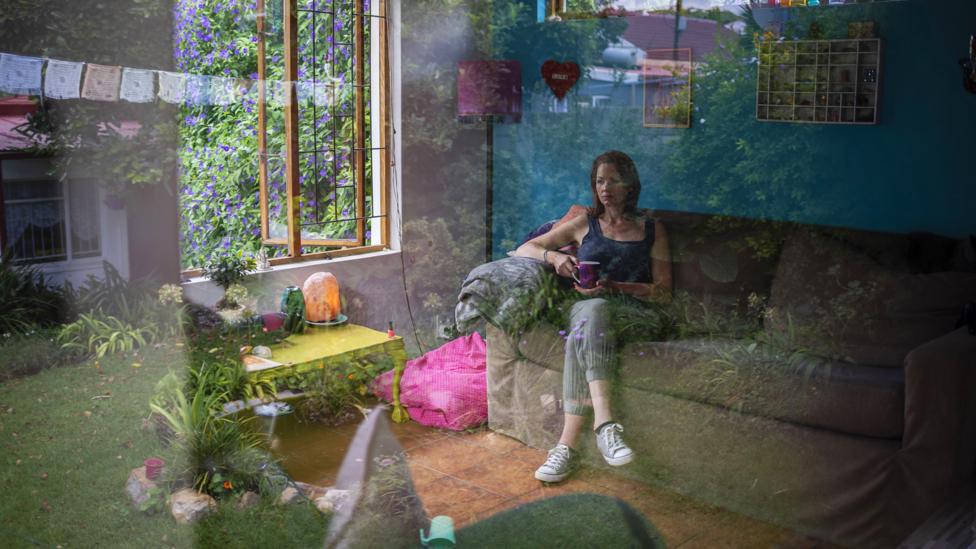
The measures put in place to prevent the spread of Covid-19 have meant many people are isolated in their homes (Credit: EPA)
“To store the filth of a city within the city is simply to invite disease and death,” wrote the authors of the 1840 book The Separate System of Sewerage, its Theory and Construction, which called for sewers to be built in New York. It went on to note that, “by sewering certain towns in England, the death rate from pulmonary diseases alone was reduced by 50%”.
Over time, cities also started implementing basic building standards including “apartments to have light and ventilation and, you know, only a certain number of people in each one,” says Shah, who explains that gradually things began to change.
In recent years, calls for cities to focus on health in their planning have been growing. “For the resilient, sustainable cities we all want and need, urban plans need to be designed, evaluated and approved using a health lens,” says Layla McCay, director for the Centre for Urban Design and Mental Health.
There are many examples of this: since 2016, the National Parks Board of Singapore has been building therapeutic gardens in public parks to boost the mental and emotional well-being of citizens. In Tokyo, citizens are working with urban designers to greenify their neighbourhoods to improve their health.
As the world’s cities have grown, urban design has actually made many of them healthy alternatives to suburban or rural living
Over the past century more and more of us have flocked to cities for work opportunities, and to be close to the sources of all our daily needs, from food to healthcare. As the world’s cities have grown, urban design has actually made many of them healthy alternatives to suburban or rural living. A 2017 study found that city living was linked to lower levels of obesity in the UK than life in the suburbs, and the story is similar in the United States. (Read more about the world’s healthiest places to live.)
But that’s not to say that city life is best when it comes to infectious diseases. In a pandemic, busy urban centres are a big part of the problem. Without speedy and efficient public health measures to counter the infection’s spread, the bigger and more well-connected a city, the faster it will travel.
“Precisely because they are hubs for transnational commerce and mobility, densely populated and hyper-connected cities can amplify pandemic risk,” wrote Rebecca Katz, co-director of the Centre for Global Health Science and Security and Robert Muggah, director at the Igarapé Institute, a Brazilian-based think tank in a piece for the World Economic Forum. With estimates that 68% of the world’s population will live in cities by 2050, the need to design cities well for pandemics will only get more pressing.
Urban hotspots
Not all cities are equally vulnerable to disease. Wealthy cities like Copenhagen, with lots of green space and provisions for cycling, are world-famous for their health benefits. But it’s a very different story for those living in the informal settlements of less economically developed cities like Nairobi, Kenya or Dhaka, Bangladesh.
Without proper sanitation or access to clean water to wash “this is where epidemics have the most potential to start and spread”, says Elvis Garcia, an expert in public health and a lecturer at the Harvard Graduate School of Design. “In 10 years, an estimated 20% of the world’s population will live in urban environments with a limited access to appropriate water, health, and sanitation infrastructures,” he says.
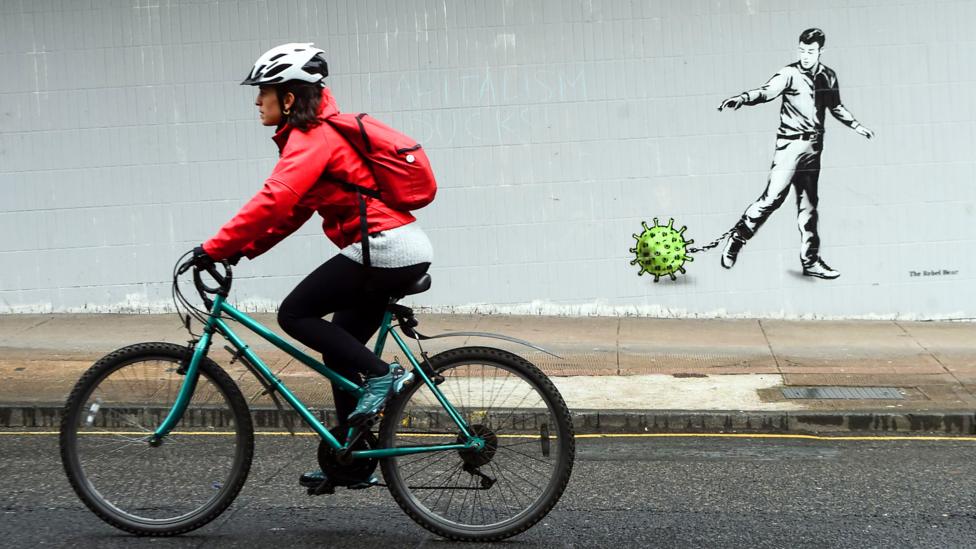
Making more space for people to get around and exercise could help to reduce the risk of infections spreading in cities (Credit: Getty Images)
Were a virus like Covid-19, which can go undetected for many days before symptoms show, to emerge among these vulnerable communities it would be disastrous, as was the case with the 2014-2016 Ebola outbreak in West Africa. The countries affected have some of the worst water, sanitation and hygiene (WASH) coverage in the world, which exacerbated the spread and reach of the Ebola outbreak, with fatal consequences, according to Oxfam International. Tackling basic sanitation is the first step in building a healthier city. “That means appropriate water and sanitation systems and good quality houses,” says Garcia. (Read more about how hand hygiene effects the spread of a virus.)
Population density is another factor that can have a big influence on the spread of infectious disease. This is because it can lead to overcrowding, which can increase the frequency of transmission. In 2002 and 2003, a housing estate in Hong Kong was at the centre of the Sars outbreak. The city and special administrative region is one of the most densely packed and unequal places in the world, and the virus eventually killed nearly 800 people.
Even with big green spaces like Central Park in Manhattan residents have struggled to stay far enough away from one another to curb the spread of the disease
Wuhan, the Chinese city where the Covid-19 outbreak began, is the most densely populated in central China, home to 11 million people. Likewise, New York, which has had the worst of the outbreak in the US, is the most densely populated city in the country. Even with big green spaces like Central Park in Manhattan and Prospect Park in Brooklyn, residents have struggled to stay far enough away from one another to curb the spread of the disease.
We can see hints of what the pandemic-resilient cities of tomorrow might look like in the way that urban spaces are being repurposed right now.
One solution to address the overcrowding issue was proposed by New York City councillor Corey Johnson in an interview with Politico: close off parts of the city to traffic and open them up for exercise. “You may be able to deliver more social distancing if you pick certain streets that could be shut down,” he said.
At a daily press conference, the Governor of New York Andrew Cuomo supported the idea of opening streets to reduce density. Their street closures lasted just 11 days, but across the globe, from Calgary to Cologne, cities have been closing off streets to give people more space. Oakland has gone as far as shutting down 74 miles of city streets for walkers and cyclists. In future cities, planning for pedestrians may even go a step further by building much wider pavements, according to the Centre for Urban Design and Mental Health’s McCay.
Access to lots of green space is also important for the mental and physical health of city residents during a pandemic. Marianthi Tatari, an architect at UNStudio Amsterdam, says, “20 minutes of ‘green time’ a day helps to give us a healthy and humane approach to our present situation”. In the UK, private green spaces were opened and subsequently closed amid fears they were helping spread the disease, but in Portland instead of closing their parks, they shut them to traffic to make more space for people to get outside. These moves are temporary for now, but as the need to social distance continues we may see more spaces pedestrianised.
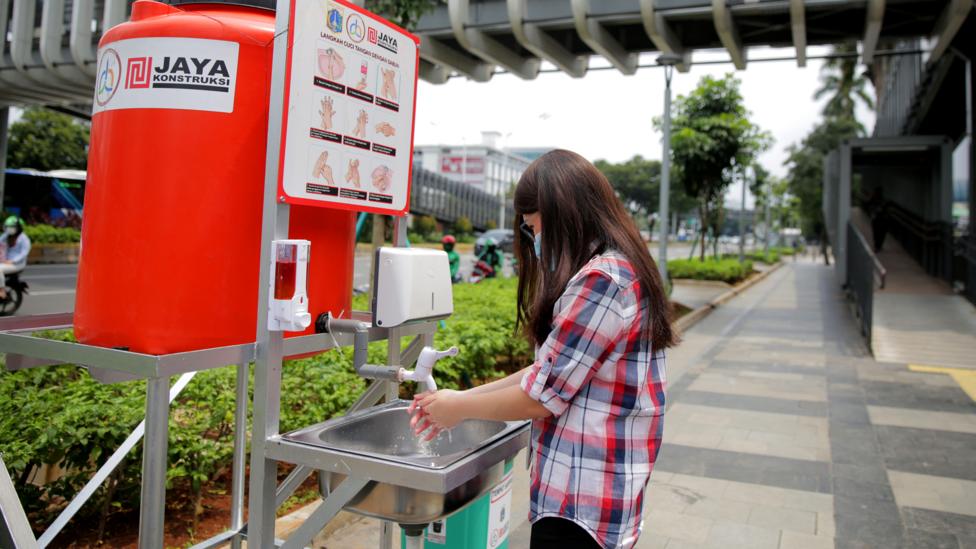
Providing handwashing facilities in public places could help to reduce the risk of passing on infections (Credit: Getty Images)
But with sanitation being such a crucial part of stemming disease, being in a park with no way to keep your hands clean could be a concern. McCay suggests the ramping up the building of hand washing stations in all cities. “If everyone was washing their hands diligently we would see a reduction in all types of infection,” she says. “Perhaps one of the reasons we’re not is because there aren’t these facilities in place.”
Jo da Silva, global sustainable development director at engineering firm ARUP suggests we might need to change the way we build our indoor environments too. In shared buildings “we might think about having more than one lift, and multiple communal staircases,” she says. Doing this avoids “pinch points”, a term for when lots of people are trying to use the same space and getting too close to each other in the process.
If pandemics are to be a regular part of our lives, our cities will need to be more adaptable, according to Johan Woltjer from University of Westminster’s School of Architecture and Cities. “During a crisis like we’re in at the moment, it would mean creating temporary housing and [having] health centres be built more flexibly and have space available in cities for those,” he says. One example of this is the temporary Nightingale Hospital in London, converted in just nine days and able to accommodate 4,000 patients and a 1,000-bed hospital in Wuhan, China, that was built from the ground up in just 10 days. Having both the space and capability to create these rapid, temporary structures will be a fundamental part of a city built for a pandemic.
In shared buildings we might think about having more than one lift, and multiple communal staircases
But cities might go beyond this “to be able to change rapidly, [from the delivery of] essential supplies, shopping and goods, to evacuation routes,” says Woltjer. Materials would need to be sourced which enabled rapid building, like timber and wood, the usage of which is already appealing to many as they are more sustainable. We may see more buildings made from shipping containers too. “There are ready-made houses and smaller buildings that can be put together like a package,” adds Woltjer.
So making different use of our current spaces, implementing further sanitation and transitioning toward more room for pedestrians are all going to be key features in a pandemic-resilient city of the future.
But one of the biggest changes to our cities won’t be so visible as a fancy new building or a big new park, according to Davina Jackson, author of Data cities: How satellites are transforming architecture and design. “Cities of the future are going to have to be designed to deal with completely invisible flows [like a global virus], and that’s where the data mapping comes in.”
She gives an example which brings us back to the urban gut of a city: researchers at the Senseable City Lab at MIT placed sensors into sewers to detect concentrations of illegal drugs and harmful bacteria in specific areas. A city built for a pandemic would likely be filled with hidden sensors to help map the spread of disease.
Self-sufficiency
Another important aspect in building a city resilient to pandemics is thinking about how to source food.
In our globalised world, resources from all corners of the world can end up in the heart of our urban centres within a matter of hours or days, and viruses hitch a ride with them. “Our cities are not citadels,” says Shah. Scientists say coronavirus likely came from bats, which passed through an intermediary species before reaching humans in Wuhan, with its large train station connecting the city to the rest of China and its busy international airport. “Five million people left Wuhan before they locked down that city, because we’re all connected,” says Shah.
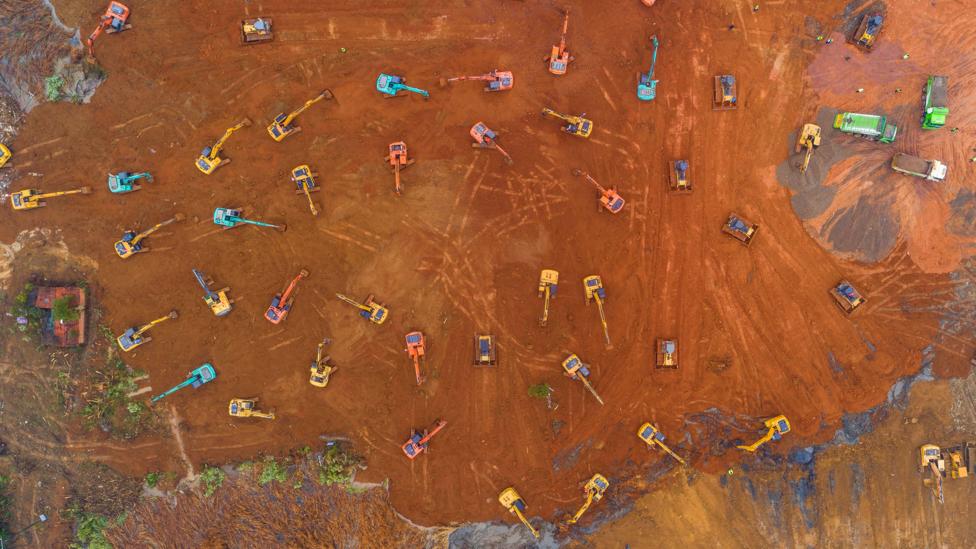
The Chinese authorities were able to build a 1,000-bed hospital in Wuhan from the ground up in just 10 days (Credit: Getty Images)
She suggests that to reduce risk, our cities may need to become more localised and self-sufficient in the future. “If you had a city, for example, that could feed itself,” Shah suggests. “It’s not like each place has to be an island, but that there’s some kind of sense of balance and sustainability that you can see within your own settlement.”
There are already examples of urban farming feeding millions when there is little other choice. During World War Two Americans planted 20 million household vegetable plots, producing nine million lbs of produce each year and amounting to 44% of the US harvest, but the challenge of building a self-sufficient city is still a huge one.
Garcia agrees that the city of the future needs to be more localised, not just in food but in access to day-to-day amenities. “Maybe in the mega-cities, you have to create small nuclear entities,” he says. “And each nuclear entity has all the resources inside.” One example of this is the 20-minute city, something that was being trialled in Melbourne, Australia before the coronavirus outbreak. In a 20-minute city, almost everything a citizen needs, from shopping to healthcare to exercise, is within a 20-minute walk or bike ride.
Localisation can also help with another sticking point in the fight against contagion – mass public transport. While hailed as an environmental solution to the pollution caused by individual car usage, public transport is not ideal in a pandemic situation. So cities would need to make more provisions for cycling, and cities may need to “offer more paths and small roads so there are alternative ways to get around: so we’re not all collectively on the same road or in the same public transport”, says Woltjer.

Therapeutic parks in Singapore are designed to boost the mental and emotional well-being of citizens (Credit: Getty Images)
Our homes will need to change too. In an effort to make them more energy and heat efficient, many workspaces, flats and apartment blocks don’t have operable windows. But if we are to going to be spending more time indoors, our houses will need to be better ventilated and offer more light, according to the Irwin S. Chanin School of Architecture’s Kallipoliti. She describes the need to avoid something called “sick building syndrome”, which is what happens “when buildings [are] entirely sealed and start recirculating pathogens through their systems”. Perhaps our homes will even be built to feature “decontamination airlocks like in a Martian environment”, she suggests.
But as the world grapples with the harsh reality of our current situation, we cannot simply build our way out of the problem. A shift in thinking is needed for any city of tomorrow, according to architect Roberto Palomba, who is currently quarantining in his home in Milan.
As a judge on a newly launched Pandemic Architecture competition, which calls for creatives to submit ideas on city design in the face of globalised health threats, he wants to focus not just on design, but on our broader relationship with nature.
“We have abused nature, and [generated] epidemics,” Palomba says. Before thinking about new cities, the focus should be on preventing new diseases from emerging in the first place. “I believe that cities against pandemics will be just that, places where each species will find respect in coexistence.”
So perhaps we shouldn’t be picturing shiny new city-centre plans when envisioning a pandemic-resilient city. The changes will be quite practical, like pop up hand washing stations, and often invisible, like tracking devices built into our sewers. If we do pandemic preparedness right, our cities might look much as they do today – just a little less crowded, with a little more local open space, and with more of the resources they need to support themselves on the doorstep.
--
As an award-winning science site, BBC Future is committed to bringing you evidence-based analysis and myth-busting stories around the new coronavirus. You can read more of our Covid-19 coverage here.
--
If you liked this story, sign up for the weekly bbc.com features newsletter, called “The Essential List”. A handpicked selection of stories from BBC Future, Culture, Worklife, and Travel, delivered to your inbox every Friday.
Can you kill coronavirus with UV light?

By Zaria Gorvett24th April 2020
There’s only one type of UV that can reliably inactivate Covid-19 – and it’s extremely dangerous.
“You would literally be frying people,” says Dan Arnold, laughing in disbelief.
Arnold works for UV Light Technology, a company that provides disinfecting equipment to hospitals, pharmaceutical companies and food manufacturers across the UK. Recently, as the global anxiety about Covid-19 has reached extraordinary new heights, he’s found himself fielding some unusual requests.
“We had an enquiry from a private individual about our equipment, saying ‘Well, why can't we just get one of your UV lights and put it up on the exit to the supermarket – people can stand under it for a few seconds before they go in’,” he says.
Among the abundant “health” advice that has been swarming around the internet in recent weeks, the idea that you can disinfect your skin, clothing or other objects with UV light has proved extremely popular – and even been mentioned by the US President.



